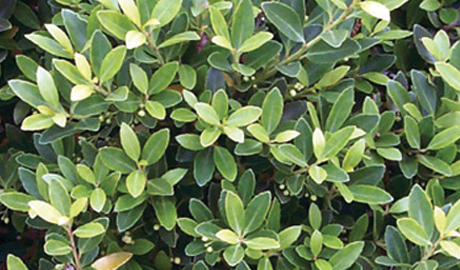Hollies

Within the Holly (Ilex) family there are many species both evergreen and deciduous. An adaptable landscape plant, their uses range from foundation shrubs, to screening and hedging, to tall specimen trees. Several are native species (Inkberry and Winterberry). For most hollies, only the female plant provides berries, with small flowers in late spring or summer, that mature into red, black, yellow or orange berries in fall and persist through the winter. Birds such as robins, cedar waxwings, cardinals, and mockingbirds love to feed on them. To optimize berry production, plant a female and male holly of the same species and that flower at the same time within 30-40’ of each other.
Culture and Care
Location – Hollies are generally trouble free and easy to grow. Most hollies grow best in full sun or partial shade, the more shade the less berry production. Avoid areas where they may be subject to drying winter winds, to avoid winter die back and browning of foliage.
Planting and Fertilizing – Hollies prefer moist well-drained, acidic soils. Winterberry and Inkberry hollies are adaptable to wetter, soggier soils. For all, amend the soil using equal parts topsoil and Stauffers Professional Planting Mix. For new plantings add Espoma Bio-tone Starter Plus (at manufacturers recommended rate) to reduce transplant shock and to establish a good, deep root system. For established hollies fertilize spring and fall with Espoma Holly-tone. Spread a 2-3” layer of mulch over the planting area being sure to keep mulch away from the trunk or stems of the plant and water thoroughly.
Pruning – While hollies are easily pruned, choose a species or cultivar that best suits the available space. Light pruning in winter for use in decorating is fine, but for more severe pruning the best time is in early spring before new growth and flowering commences. Inkberry, Blue and Japanese hollies are often sheared to maintain size and shape.
Stauffers of Kissel Hill Hollies
English Holly (Ilex aquifolium) Known for its glossy spine tipped foliage and showy red fruit. Tree form in habit, many varieties have variegated foliage (Santa’s Delight). Less winter hardy than many new hybrids available. Male holly needed for fruit set.
American Holly (Ilex opaca) Slow growing conical shaped tree hollies used as specimen plants in the landscape. Male holly needed for fruit set.
Japanese Holly (Ilex crenata) Numerous cultivars typically with dense, oval to rounded shape often used as foundation plants because of their size and tolerance of pruning and shaping. Leaves are relatively small and spineless. Popula cultivars include: Green Lustre, Hoogendorn, Helleri, Sky Pencil (narrow upright), Steeds (upright conical).
Inkberry Holly (Ilex glabra) A native, multi-branched shrub species with oval to oblong glossy green foliage. Commonly used in mass plantings, hedging, border, and foundation plantings. Tolerant of most any soil and pruning. Black berries on inner branches of female plants. Popular cultivars include: Shamrock and Densa.
Blue Holly (Ilex meserveae) The blue hollies are a group of medium to large shrub cultivars hybridized for cold hardiness and attractive blue-green foliage. Female cultivars bear showy red persistent fruit (male blue holly needed for pollination). They are suitable for mass planting, hedges, and foundation plants. Popular cultivars include: Blue Prince, Blue Princess, Blue Angel, Blue Maid, Castle Spire, Castle Wall.
Hybrid Hollies There are many popular evergreen hollies in this category, with many different features and sizes for the landscape. Most are upright to conical tree forms such as: Nellie Stevens (self pollinating), Centennial Girl, Dragon Lady, Red Beauty, Christmas Jewel, and Winter Bounty.
Winterberry Holly (Ilex verticillata) Excellent for mass effect, shrub borders, and wet areas. These deciduous hollies are best known for their outstanding red fruits in winter on female plants. Varying size and shapes, most are upright to broad-rounded.
Popular female varieties include: Winter Red, Sprite, Afterglow, Berry Heavy, Berry Nice, Sparkleberry. Male pollinators include: Jim Dandy, Early Male, Apollo (see winterberry pollination handout for best combinations).
